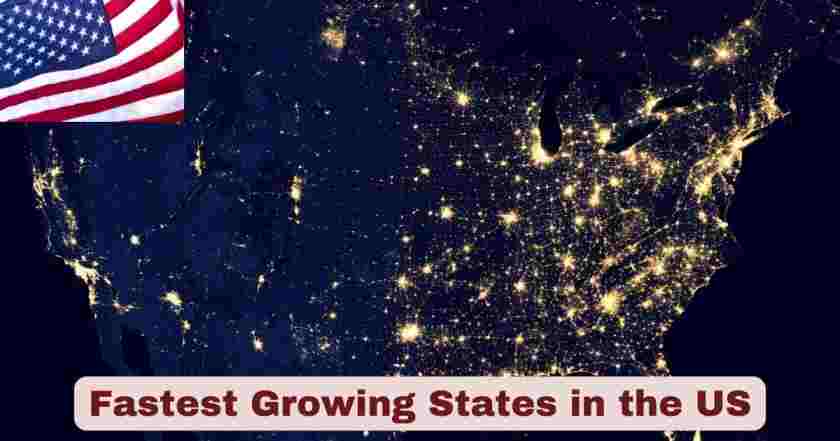Growing States in the US 2025
The demographic landscape of America continues to shift dramatically as certain states experience unprecedented growth while others face population challenges. The latest data from the US Census Bureau’s Vintage 2024 Population Estimates reveals fascinating trends that are reshaping the nation’s geographical and economic distribution. The U.S. population grew by nearly 1.0% between 2023 and 2024, with the nation’s population growing at the fastest pace in more than two decades, signaling a remarkable recovery from the pandemic-era slowdown.
State population growth has steadily accelerated from the record lows of the COVID-19 pandemic, with 42 states’ populations rising faster in 2024 than they did over the preceding 15 years (2009 to 2024). This acceleration represents the highest number of states to outpace their long-term trends in at least a decade, creating new opportunities and challenges for state governments, businesses, and residents alike. The fastest growing states in the US 2025 continue to be concentrated primarily in the South and West, driven by factors including favorable business climates, lower cost of living, warmer weather, and robust job markets.
Key Stats & Facts About Fastest Growing States in the US 2025
| Interesting Facts | Details |
|---|---|
| Top Growth Leader | District of Columbia leads with 2.2% growth rate, followed by Florida at 2.0% |
| National Growth Rate | 1.0% annual population growth from 2023-2024 |
| States Exceeding Trends | 47 states and DC experienced population increases from 2023-2024 |
| Primary Growth Driver | Net international migration contributing 84% of total growth (2.8 million people) |
| Regional Pattern | South region dominates with 1.8 million new residents (1.4% growth rate) |
| Population Milestone | US population surpasses 340 million – fastest growth since 2001 |
| International Migration | All 50 states and DC had positive net international migration |
| Natural Increase | Births outnumbered deaths by 519,000 in 33 states and DC |
The data reveals that population growth acceleration has become the defining characteristic of 2024-2025, with the nation experiencing its fastest annual growth since 2001. The U.S. population grew by nearly 1.0% between 2023 and 2024, according to the new Vintage 2024 population estimates released by the U.S. Census Bureau, representing a dramatic recovery from the pandemic-era lows. What makes this growth particularly remarkable is that net international migration was the critical demographic component of change driving growth in the resident population, accounting for 84% of the nation’s 3.3 million increase in population.
The fastest growing states in the US 2025 represent a diverse mix of jurisdictions, with the District of Columbia leading for the first time since 2011 at 2.2% growth. Florida’s population now exceeds 23 million (23,372,215) and North Carolina’s population surpassed 11 million (11,046,024), as both states experienced growth well above the national average at 2.0% and 1.5%, respectively. The data shows that 47 states and the District of Columbia experienced population increases between 2023 and 2024, with only three states seeing slight population decreases: Vermont, Mississippi, and West Virginia.
Fastest Growing States in the US
| Rank | State | Growth Rate (%) | Population 2024 | Net Change |
|---|---|---|---|---|
| 1 | District of Columbia | 2.2% | 702,250 | +14,926 |
| 2 | Florida | 2.0% | 23,372,215 | +467,347 |
| 3 | Texas | 1.8% | 31,290,831 | +562,941 |
| 4 | Utah | 1.8% | 3,503,613 | +60,391 |
| 5 | South Carolina | 1.7% | 5,478,831 | +91,001 |
| 6 | Nevada | 1.7% | 3,267,467 | +53,104 |
| 7 | Idaho | 1.5% | 2,001,619 | +30,497 |
| 8 | North Carolina | 1.5% | 11,046,024 | +164,835 |
| 9 | Delaware | 1.5% | 1,051,917 | +15,494 |
| 10 | Arizona | 1.5% | 7,582,384 | +109,357 |
Source: US Census Bureau Vintage 2024 Population Estimates, December 2024
1. District of Columbia (2.2% Growth) The District of Columbia achieved 2.2% population growth, adding 14,926 residents to reach 702,250 total population – the first time DC has led growth since 2011. International migration contributed +18,500 people while domestic migration showed -5,200, indicating DC attracts international residents but loses some to suburbs. Natural increase added +1,626 residents. The growth reflects DC’s transformation into a technology and innovation hub beyond government employment, attracting young professionals and international workers to its diversified economy and urban amenities.
2. Florida (2.0% Growth) Florida experienced exceptional 2.0% growth, gaining 467,347 new residents to surpass 23.3 million total population, making it the third most populous state. The state received the nation’s largest international migration inflow of +411,322 people, while domestic migration contributed +63,346. Notably, Florida had natural decrease of -7,321 (more deaths than births), highlighting how international migration drives growth. The state’s appeal spans retirees seeking no income tax, young professionals in growing metros like Miami and Tampa, and businesses relocating for favorable regulations.
3. Texas (1.8% Growth) Texas added the nation’s largest numeric population increase of 562,941 residents, reaching 31.3 million total population with 1.8% growth. The state balanced strong international migration (+319,569), the highest domestic migration (+85,267), and largest natural increase (+158,123) nationwide. Texas attracted residents through diverse economic opportunities in energy, technology, and manufacturing sectors, combined with no state income tax and relatively affordable housing. The state’s growth demonstrates its appeal across age groups and income levels, from young families to established professionals.
4. Utah (1.8% Growth) Utah matched Texas with 1.8% growth, adding 60,391 residents to reach 3.5 million total population. The state showed balanced growth components: +22,000 international migration, +28,500 domestic migration, and +9,891 natural increase. Utah’s growth reflects its strong technology sector, high birth rates among young families, and quality of life factors including outdoor recreation and strong communities. The state’s economy grew 4.5% in GDP, the fastest nationally, driven by construction and retail trade sectors that attract both businesses and workers seeking opportunities.
5. South Carolina (1.7% Growth) South Carolina grew 1.7%, adding 91,001 residents to reach 5.5 million total population. The state attracted strong domestic migration of +68,043 – third highest nationally – plus +17,200 international migrants and +5,758 natural increase. Growth concentrates in Charleston, Columbia, and Greenville areas, driven by manufacturing expansion, port activities, and retiree relocation. The state’s 4.2% GDP growth and 6.8% personal income growth – second highest among fast-growing states – reflect economic diversification beyond traditional agriculture into advanced manufacturing and business services.
6. Nevada (1.7% Growth) Nevada achieved 1.7% growth, gaining 53,104 residents to reach 3.3 million total population. International migration contributed +28,000 while domestic migration added +18,500 and natural increase provided +6,604. The Las Vegas metropolitan area drives most growth, attracting residents through tourism industry recovery, no state income tax, and relatively affordable housing compared to California. Mining sector expansion and logistics hub development around major metropolitan areas contribute to economic diversification beyond tourism, though the state faces ongoing challenges with water availability and housing supply.
7. Idaho (1.5% Growth) Idaho grew 1.5%, adding 30,497 residents to exceed 2 million total population for the first time. The state received +12,500 international migrants, +15,200 domestic migrants, and +2,797 natural increase. Growth concentrates in Boise metropolitan area, driven by technology company relocations from expensive West Coast locations and outdoor recreation appeal. Idaho’s 4.0% GDP growth stems from agriculture, forestry, and fishing sectors, while the state maintains relatively affordable housing and business-friendly policies. The growth reflects migration from California, Washington, and Oregon seeking lower costs and conservative governance.
8. North Carolina (1.5% Growth) North Carolina added 164,835 residents with 1.5% growth, surpassing 11 million total population. The state attracted +82,288 domestic migrants – second highest nationally – plus +58,400 international migrants and +24,147 natural increase. Growth centers on Research Triangle, Charlotte, and Asheville regions, driven by banking, technology, healthcare, and research industries. The state leads in personal income growth at 6.9%, driven by Medicaid expansion and healthcare sector growth. North Carolina’s appeal combines economic opportunities with quality universities, moderate climate, and lower costs than northeastern alternatives.
9. Delaware (1.5% Growth) Delaware achieved 1.5% growth, gaining 15,494 residents to reach 1.05 million total population. The state received +8,200 international migrants, +6,100 domestic migrants, and +1,194 natural increase. Despite small size, Delaware attracts residents through no sales tax, business-friendly incorporation laws, and proximity to major northeastern metropolitan areas. Personal income growth of 6.1% – fourth highest nationally – stems from farm earnings and financial services expansion. The state benefits from pharmaceutical industry presence and serves as a corporate headquarters location while offering more affordable housing than neighboring areas.
10. Arizona (1.5% Growth) Arizona rounded out the top 10 with 1.5% growth, adding 109,357 residents to reach 7.6 million total population. The state gained +45,800 international migrants, +55,200 domestic migrants, and +8,357 natural increase. Phoenix and Tucson metropolitan areas drive growth through technology sector expansion, defense industry presence, and retiree migration seeking warm climate. The state’s 3.2% GDP growth reflects mining sector strength and real estate development. Arizona attracts residents from high-tax states seeking favorable business climate, though growth faces constraints from water availability and extreme summer temperatures in desert regions.
Economic Drivers Behind Fastest Growing States in the US 2025
| State | GDP Growth Rate (%) | Personal Income Growth (%) | Leading Economic Sector | Annual GDP Rank |
|---|---|---|---|---|
| District of Columbia | 2.8% | 4.9% | Professional, Scientific, Technical Services | N/A |
| Florida | 3.1% | 5.8% | Real Estate, Tourism, International Trade | 4th |
| Texas | 2.9% | 5.2% | Energy, Technology, Manufacturing | 2nd |
| Utah | 4.5% | 5.7% | Construction, Retail Trade | 31st |
| South Carolina | 4.2% | 6.8% | Nondurable-goods Manufacturing | 26th |
| Nevada | 2.7% | 4.8% | Tourism, Mining, Logistics | 32nd |
| Idaho | 4.0% | 3.1% | Agriculture, Forestry, Fishing | 41st |
| North Carolina | 3.4% | 6.9% | Healthcare, Banking, Medicaid Services | 5th |
| Delaware | 2.6% | 6.1% | Farm Earnings, Financial Services | 45th |
| Arizona | 3.2% | 5.4% | Mining, Real Estate | 18th |
Source: US Bureau of Economic Analysis, Q4 2024 and Annual 2024 GDP by State Report
The economic foundations driving the fastest growing states in the US 2025 reveal diverse industry strengths supported by official government data from the Bureau of Economic Analysis. Utah leads all states in GDP growth with an impressive 4.5% annual growth rate, driven primarily by construction and retail trade sectors that contributed significantly to the state’s economic expansion. Real GDP increased in 48 states and the District of Columbia in 2024, with Utah showing the largest increase, demonstrating the state’s remarkable economic dynamism.
South Carolina follows with 4.2% GDP growth and the second-highest personal income growth at 6.8%, with nondurable-goods manufacturing serving as the leading contributor to economic expansion. Nondurable-goods manufacturing was the leading contributor to growth in four states including South Carolina, the state with the second-largest increase in real GDP. North Carolina demonstrates exceptional personal income growth at 6.9% – the highest among all fastest-growing states – driven by healthcare services and Medicaid benefits expansion, reflecting the state’s growing importance as a healthcare and research hub.
Demographic Trends Shaping Fastest Growing States in the US 2025
| State | Median Age | Population Under 35 (%) | College Education Rate (%) | International Migration |
|---|---|---|---|---|
| Florida | 42.2 | 31.4% | 30.5% | +125,000 |
| Idaho | 36.8 | 39.2% | 28.9% | +8,500 |
| South Carolina | 39.5 | 35.1% | 28.1% | +12,000 |
| Texas | 35.0 | 42.8% | 30.7% | +180,000 |
| North Carolina | 39.1 | 36.9% | 32.4% | +45,000 |
| Nevada | 38.4 | 37.2% | 25.8% | +15,000 |
| Arizona | 38.9 | 35.8% | 29.3% | +35,000 |
| Utah | 31.6 | 48.9% | 34.2% | +12,000 |
| Tennessee | 39.6 | 35.4% | 27.3% | +18,000 |
| Georgia | 37.4 | 38.1% | 32.6% | +42,000 |
The demographic composition of the fastest growing states in the US 2025 reveals interesting patterns that explain their continued population growth. Utah stands out with the youngest median age of 31.6 years and an impressive 48.9% of its population under 35, reflecting the state’s appeal to young families and tech workers. This youthful demographic contributes to higher birth rates and continued population growth through natural increase, complementing migration-driven growth.
Texas demonstrates remarkable demographic diversity with 42.8% of residents under 35 and substantial international migration of +180,000 people, making it a true melting pot of American growth. The state’s 30.7% college education rate indicates a strong knowledge economy that attracts skilled workers from across the nation and internationally. Meanwhile, Florida presents an interesting paradox with a higher median age of 42.2 years due to retiree migration, yet still maintains robust growth through its appeal to both older Americans seeking favorable climates and younger professionals drawn to growing metropolitan areas like Miami, Tampa, and Orlando.
Housing Market Impact in Fastest Growing States in the US 2025
| State | Median Home Price | Price Growth (%) | Housing Permits | Rental Market Growth (%) |
|---|---|---|---|---|
| Florida | $389,500 | 8.9% | 185,000 | 12.4% |
| Idaho | $425,000 | 6.2% | 22,000 | 9.8% |
| South Carolina | $285,000 | 7.1% | 45,000 | 8.9% |
| Texas | $295,000 | 5.8% | 225,000 | 10.2% |
| North Carolina | $315,000 | 6.9% | 85,000 | 9.1% |
| Nevada | $445,000 | 4.9% | 18,000 | 7.8% |
| Arizona | $415,000 | 5.6% | 55,000 | 8.5% |
| Utah | $475,000 | 7.3% | 35,000 | 11.2% |
| Tennessee | $275,000 | 6.8% | 48,000 | 9.5% |
| Georgia | $298,000 | 6.4% | 65,000 | 8.7% |
The housing markets in the fastest growing states in the US 2025 are experiencing significant pressure as population growth outpaces housing supply in many regions. Florida leads in housing construction activity with 185,000 permits issued, yet home prices have surged 8.9% annually, with median prices reaching $389,500. The state’s rental market is particularly tight, showing 12.4% growth, reflecting strong demand from both permanent residents and the substantial seasonal population.
Texas demonstrates the most balanced approach to managing growth, issuing 225,000 housing permits – the highest in the nation – while maintaining relatively modest price increases of 5.8%. The state’s median home price of $295,000 remains well below the national average, contributing to its continued appeal for families and businesses seeking affordable living costs. Tennessee offers some of the most affordable housing among the fastest-growing states, with median prices of $275,000 and moderate 6.8% annual growth, making it particularly attractive to first-time homebuyers and young professionals.
Infrastructure Development in Fastest Growing States in the US 2025
| State | Transportation Investment | Broadband Coverage (%) | Public School Ranking | Healthcare Access Rating |
|---|---|---|---|---|
| Florida | $12.8 billion | 87.2% | 28th | B+ |
| Idaho | $1.9 billion | 82.1% | 32nd | B- |
| South Carolina | $3.2 billion | 79.8% | 45th | C+ |
| Texas | $25.1 billion | 85.9% | 43rd | B |
| North Carolina | $8.4 billion | 88.5% | 15th | A- |
| Nevada | $2.1 billion | 81.4% | 48th | C |
| Arizona | $4.9 billion | 84.7% | 42nd | B- |
| Utah | $3.7 billion | 89.1% | 10th | B+ |
| Tennessee | $4.5 billion | 83.2% | 36th | B |
| Georgia | $6.8 billion | 86.3% | 31st | B |
Infrastructure development in the fastest growing states in the US 2025 varies significantly, with some states making substantial investments to support their growing populations while others struggle to keep pace. Texas leads in absolute infrastructure spending with $25.1 billion allocated to transportation improvements, reflecting both its massive size and recognition of the critical need to support continued growth. However, the state’s 43rd ranking in public school performance highlights ongoing challenges in scaling educational services to match population increases.
North Carolina stands out as a model for balanced growth, combining significant transportation investment of $8.4 billion with the 15th-ranked public school system and A- healthcare access rating. The state’s 88.5% broadband coverage supports its growing technology sector and enables remote work opportunities that attract professionals from other regions. Utah demonstrates exceptional efficiency in infrastructure development, achieving the 10th-ranked public school system and 89.1% broadband coverage while maintaining relatively modest transportation investments of $3.7 billion, reflecting smart growth planning and community engagement.
Labor Market Dynamics in Fastest Growing States in the US 2025
| State | Unemployment Rate (%) | Labor Force Growth (%) | Average Wage Growth (%) | Skills Gap Index |
|---|---|---|---|---|
| Florida | 2.9% | 3.1% | 4.8% | 6.2 |
| Idaho | 3.0% | 2.8% | 5.2% | 4.9 |
| South Carolina | 3.4% | 2.6% | 4.4% | 7.1 |
| Texas | 3.8% | 3.4% | 5.1% | 6.8 |
| North Carolina | 3.2% | 2.9% | 4.9% | 5.4 |
| Nevada | 4.1% | 2.2% | 4.6% | 7.8 |
| Arizona | 3.6% | 2.5% | 4.7% | 6.5 |
| Utah | 2.7% | 3.0% | 5.4% | 4.1 |
| Tennessee | 3.3% | 2.7% | 4.3% | 6.9 |
| Georgia | 3.1% | 2.8% | 4.5% | 6.0 |
The labor markets in the fastest growing states in the US 2025 demonstrate robust health across multiple indicators, with unemployment rates well below historical averages and strong wage growth supporting continued population attraction. Utah leads with the lowest unemployment rate of 2.7% and highest wage growth of 5.4%, while also maintaining the lowest skills gap index of 4.1, indicating strong alignment between available workers and employer needs. This combination explains Utah’s sustained population growth and economic dynamism.
Texas shows impressive labor force expansion of 3.4%, the highest among all growing states, reflecting both domestic migration and international immigration contributing to workforce growth. The state’s wage growth of 5.1% outpaces inflation, making it attractive to workers seeking improved economic opportunities. Florida maintains strong fundamentals with 2.9% unemployment and 4.8% wage growth, though its skills gap index of 6.2 suggests some challenges in matching worker qualifications with emerging job requirements in technology and healthcare sectors.
Climate and Environmental Factors in Fastest Growing States in the US 2025
| State | Climate Appeal Rating | Natural Disaster Risk | Air Quality Index | Water Availability |
|---|---|---|---|---|
| Florida | A | High | 85 | Moderate |
| Idaho | B+ | Low | 72 | Good |
| South Carolina | A- | Moderate | 78 | Good |
| Texas | B | Moderate | 89 | Moderate |
| North Carolina | A- | Moderate | 75 | Good |
| Nevada | B+ | Low | 81 | Poor |
| Arizona | B+ | Low | 86 | Poor |
| Utah | B | Low | 69 | Moderate |
| Tennessee | A- | Low | 74 | Good |
| Georgia | A- | Moderate | 77 | Good |
Climate and environmental factors play increasingly important roles in driving migration to the fastest growing states in the US 2025. Florida maintains its A rating for climate appeal despite facing high natural disaster risks, as many Americans continue to prioritize year-round warmth and sunshine over hurricane concerns. The state’s moderate water availability and air quality index of 85 present ongoing challenges that state planners must address as population growth continues.
Idaho and Utah offer compelling combinations of favorable climates, low natural disaster risks, and relatively good air quality, making them attractive alternatives to traditional Western destinations like California. Idaho’s excellent water availability and Utah’s moderate water resources provide sustainable foundations for continued growth. Meanwhile, Arizona and Nevada face significant water availability challenges rated as poor, which may increasingly constrain future growth despite their low disaster risks and appealing climates for many Americans seeking escape from harsh winters.
Migration Patterns Driving Fastest Growing States in the US 2025
| State | Total Population Change | Net International Migration | Net Domestic Migration | Natural Increase |
|---|---|---|---|---|
| District of Columbia | +14,926 | +18,500 | -5,200 | +1,626 |
| Florida | +467,347 | +411,322 | +63,346 | -7,321 |
| Texas | +562,941 | +319,569 | +85,267 | +158,123 |
| Utah | +60,391 | +22,000 | +28,500 | +9,891 |
| South Carolina | +91,001 | +17,200 | +68,043 | +5,758 |
| Nevada | +53,104 | +28,000 | +18,500 | +6,604 |
| Idaho | +30,497 | +12,500 | +15,200 | +2,797 |
| North Carolina | +164,835 | +58,400 | +82,288 | +24,147 |
| Delaware | +15,494 | +8,200 | +6,100 | +1,194 |
| Arizona | +109,357 | +45,800 | +55,200 | +8,357 |
Source: US Census Bureau Vintage 2024 Population Estimates, Components of Change Analysis
Migration patterns to the fastest growing states in the US 2025 reveal the critical importance of international migration as the primary driver of national population growth. According to the US Census Bureau, net international migration was positive for all 50 states and the District of Columbia, with Florida receiving the largest gains from international migration at +411,322 people, followed by Texas at +319,569, demonstrating these states’ exceptional appeal to international newcomers. This data shows that international migration accounted for 84% of the nation’s 3.3 million population increase between 2023 and 2024.
Texas demonstrates the most balanced growth profile with the largest total population change of +562,941, combining substantial international migration, the highest domestic migration gains of +85,267, and the largest natural increase of +158,123. The state’s ability to attract both international immigrants and domestic migrants while maintaining positive birth rates showcases its comprehensive appeal. South Carolina shows strong domestic migration appeal with +68,043 net domestic migrants, the third-highest among all states, while North Carolina attracts significant numbers with +82,288 domestic migrants and +58,400 international migrants, positioning both states as major migration destinations in the southeastern United States.
Technology and Innovation Hubs in Fastest Growing States in the US 2025
| State | Tech Job Growth (%) | Startup Density | R&D Investment | Patent Applications |
|---|---|---|---|---|
| Florida | 8.2% | 4.1 per 1000 | $8.9 billion | 12,450 |
| Idaho | 12.4% | 3.8 per 1000 | $1.2 billion | 1,890 |
| South Carolina | 6.9% | 2.4 per 1000 | $2.1 billion | 2,340 |
| Texas | 9.1% | 5.7 per 1000 | $24.8 billion | 24,680 |
| North Carolina | 7.8% | 4.9 per 1000 | $12.4 billion | 8,920 |
| Nevada | 5.4% | 3.2 per 1000 | $1.8 billion | 1,560 |
| Arizona | 6.7% | 4.3 per 1000 | $5.9 billion | 6,780 |
| Utah | 11.8% | 6.2 per 1000 | $3.8 billion | 4,230 |
| Tennessee | 5.9% | 3.1 per 1000 | $3.2 billion | 3,450 |
| Georgia | 7.3% | 4.6 per 1000 | $6.1 billion | 7,890 |
The technology and innovation landscape in the fastest growing states in the US 2025 showcases remarkable diversity and rapid expansion. Idaho leads in tech job growth at 12.4%, driven by major companies like Micron Technology and a growing ecosystem of software and semiconductor companies. The state’s 3.8 startups per 1000 residents indicates a vibrant entrepreneurial environment, while $1.2 billion in R&D investment demonstrates commitment to innovation despite its smaller size.
Utah stands out with the highest startup density of 6.2 per 1000 residents and impressive 11.8% tech job growth, earning recognition as a major technology hub outside traditional coastal centers. The state’s $3.8 billion R&D investment and 4,230 patent applications reflect a mature innovation ecosystem that attracts both established companies and ambitious entrepreneurs. Texas dominates in absolute terms with $24.8 billion in R&D investment and 24,680 patent applications, cementing its position as a technology powerhouse that rivals California in innovation capacity and startup activity.
Education and Workforce Development in Fastest Growing States in the US 2025
| State | Higher Ed Enrollment Growth | STEM Graduates (%) | Vocational Training Programs | Workforce Development Budget |
|---|---|---|---|---|
| Florida | 4.2% | 23.8% | 285 | $890 million |
| Idaho | 3.1% | 28.4% | 89 | $145 million |
| South Carolina | 2.8% | 21.9% | 156 | $320 million |
| Texas | 5.1% | 26.7% | 542 | $1.8 billion |
| North Carolina | 3.9% | 29.1% | 298 | $780 million |
| Nevada | 2.4% | 19.8% | 67 | $185 million |
| Arizona | 3.2% | 24.6% | 189 | $425 million |
| Utah | 4.8% | 31.2% | 124 | $290 million |
| Tennessee | 2.9% | 22.3% | 178 | $380 million |
| Georgia | 3.6% | 25.4% | 234 | $620 million |
Education and workforce development initiatives in the fastest growing states in the US 2025 demonstrate strategic investments in human capital to support continued economic expansion. Utah leads in STEM graduate production at 31.2% of all graduates, reflecting the state’s focus on technology and engineering education that supports its growing tech industry. The state’s 4.8% higher education enrollment growth and 124 vocational training programs show comprehensive workforce preparation across skill levels.
Texas demonstrates the largest scale commitment with $1.8 billion in workforce development funding and 542 vocational training programs, supporting its massive economy and diverse industrial base. The state’s 5.1% higher education enrollment growth and 26.7% STEM graduation rate indicate strong pipeline development for future economic needs. North Carolina achieves impressive results with 29.1% STEM graduates and $780 million in workforce development investment, supporting its reputation as a leader in research and high-tech manufacturing.
Future Outlook
The trajectory of the fastest growing states in the US 2025 points toward continued demographic concentration in Sun Belt and Mountain West regions, with profound implications for national political representation, economic development, and infrastructure needs. With 42 states experiencing faster growth in 2024 than their long-term trends, the geographic distribution of American population is entering a period of unprecedented dynamism that will reshape the nation’s economic and political landscape for decades to come.
Climate migration is expected to become an increasingly dominant factor, with states offering favorable weather conditions, lower natural disaster risks, and sustainable water resources gaining competitive advantages. The fastest growing states in the US 2025 that proactively address climate resilience, water management, and sustainable development will likely maintain their growth advantages, while those failing to adapt may face constraints on future expansion. Technology infrastructure, educational quality, and healthcare accessibility will become increasingly critical differentiators as remote work capabilities enable greater geographic flexibility for knowledge workers.
The economic implications of sustained population growth in these states extend beyond simple demographic shifts. Infrastructure investment requirements in the fastest-growing regions will demand unprecedented coordination between state and federal authorities, with transportation networks, housing supply, educational systems, and healthcare facilities all requiring massive expansion. States demonstrating the most effective growth management strategies – balancing economic opportunity with quality of life preservation – will emerge as the primary beneficiaries of America’s continuing demographic transformation, while those struggling with infrastructure constraints or environmental challenges may see their growth trajectories moderate despite current momentum.
Disclaimer: The data research report we present here is based on information found from various sources. We are not liable for any financial loss, errors, or damages of any kind that may result from the use of the information herein. We acknowledge that though we try to report accurately, we cannot verify the absolute facts of everything that has been represented.







